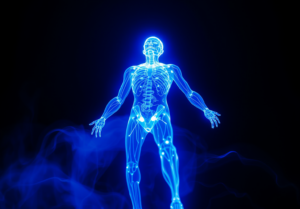I want to share with you today something I had to learn the hard way. Almost a decade ago, I was hit by Lyme disease—and I got hit hard.
After spending over $200,000 out of pocket on failed treatments (none of which were covered by insurance btw, because Lyme wasn’t taken seriously back then), I did what I had to do—I took healing into my own hands.
That led me to study the sympathetic and parasympathetic systems, not from a theoretical place, but from a desperate need to stay alive and function.
I learned what each system does for the body: one fuels action and urgency, the other allows for repair and regeneration. I experimented with ways to manually activate them—to surge with just enough energy before coaching a client, or to drop deep into healing mode when I could rest.
I learned how each of the two systems (sympathetic and parasympathetic) supports a distinct aspect of physical healing, and how to activate them on demand. I developed my own activation techniques to boost energy before client sessions and to trigger deep healing when I could afford to go offline for a few hours.
Later, as I worked with clients, it became clear I could use these same tools to help them regulate productivity, performance, and physiological restoration—because when the body heals, performance naturally rises.
So, I took it further. I mapped out which system should be activated for specific critical events and desired outcomes. Eventually, I merged this nervous system switching framework (autonomic flexibility activation) with my two proprietary methodologies—what I later named MMB Hypnosis and the CBAS Method (both techniques are used in what is now the MetaMind Bend Framework).
Combining my cognitive executive and business coaching framework (that includes mindset shifts and business strategies and tactics) with this idea of switching for on-demand autonomic flexibility, CBAS and MMB Hypnosis, allowed for a highly potent high performance system to emerge. A system powerful enough to transform the way executives lead, perform, and recover. And I’m excited to share it with you.
When I wove various MMB techniques into the nervous system switching protocol, this new kind of high-performance system allows high-stakes decision makers to perform at their peak not by pushing harder, but by becoming neurologically agile. A system that trains leaders to regulate identity, state, and somatic response in alignment with their most critical outcomes. That’s what I want to share with you today.
So, let’s start here…
Why Peak Performers Fail Under Pressure? It’s Not Mindset, It’s Autonomic Rigidity.
Autonomic rigidity is the inability to fluidly transition between physiological states. In high-stakes conditions, you might be anchored to a single autonomic pattern—often sympathetic hyperarousal—regardless of contextual demands. No amount of affirmations or visualization can override a dysregulated nervous system in real time. The deficit is not mental attitude, but neural inflexibility.
What is Needed Is Understanding Of Autonomic Flexibility and Your Hidden Executive Operating System/
Autonomic flexibility refers to the precise modulation of neural state in accordance with situational complexity. It is the body’s covert control panel, toggling between sympathetic mobilization and parasympathetic recovery with a precision that determines your cognitive clarity, vocal tone, eye contact, and decision latency. Think of it not as stress management, but as neurological state precision under volatility.
Let’s talk About Sympathetic vs. Parasympathetic: What These Systems Actually Do in High-Stakes Moments.
The sympathetic system is not “bad” and the parasympathetic is not “good.” This binary view is primitive. Sympathetic activation drives mobilization—decisive speech, assertive conflict handling, rapid appraisal. Parasympathetic tone permits social connection, ethical reasoning, and vocal prosody. For example:
- Negotiation demands controlled sympathetic drive for firmness, then parasympathetic rebound for trust-building.
- Public speaking requires a parasympathetic base (to slow speech, project warmth), then sympathetic edge for rhetorical force.
- Crisis response relies on selective sympathetic arousal without cognitive hijack—the rarest skill in corporate leadership.
And what is the cost of state misalignment? The wrong nervous system response wrecks performance.
Autonomic mismatch—being in the wrong physiological state for the task—distorts perception and degrades output.
- Anxiety before speaking is not irrational fear; it’s an autonomic script.
- Emotional hijack in conflict is not temperament—it’s limbic override due to lack of parasympathetic anchoring.
- Freeze in decision-making is not indecisiveness; it’s dorsal vagal collapse, usually from unresolved physiological overload.
Each of these conditions mimics character flaws but is in fact a failure of state-to-context alignment.
So…
What do Elite Military, Athletes, and Speakers Know About State Control That You Might Not?
Navy SEALs, Olympic athletes, and elite performers are not just talented; they are state-calibrated. They train the ability to enter high-stress zones with autonomic clarity (whether they understand autonomic mechanisms or use a different lingo for it).
SEALs practice “box breathing” not for calm, but to stabilize vagal tone mid-threat. Elite speakers rehearse nervous system readiness, not just scripts.
Executives, by contrast, are trained for cognitive strategy but leave the body entirely out of the equation, assuming it will cooperate. It often doesn’t.
Without neurophysiological training, even the most intelligent minds short-circuit under interpersonal volatility.
Now…
What Is The Science Behind State Regulation?
Let’s talk Vagal Tone, HRV, and Prefrontal Shutdown.
Vagal tone is the regulatory capacity of your parasympathetic nervous system. High vagal tone means rapid recovery from stress, emotional clarity, and better social signaling.
Heart Rate Variability (HRV) is its biometric fingerprint. Low HRV correlates with burnout, reactivity, and executive dysfunction.
When under autonomic duress, prefrontal regions deactivate—you literally lose access to reasoning, empathy, and ethical processing. This is not psychological fragility; it’s cortical triage under physiological load.
Why Do Traditional Coaching Frameworks Fail?
By Now You Probably Understand Why – Strategy Without State Is Useless.
Cognitive executive and life coaching focuses on frameworks, models, and action plans. Business coaching focuses on strategies and tactics.
Yes, I work with all that and have been very effective. BUT…
Without autonomic readiness, all strategies collapse under real-time pressure.
I see it again and again..
You can rehearse conflict resolution scripts endlessly, but IN THE BOARDROOM (AND OFTEN IN THE BEDROOM – trust me on that one, I was married and almost married–a few times each), IT’S YOUR VAGUS NERVE THAT DECIDES WHO SPEAKS—THE REGULATED ADULT OR THE REACTIVE CHILD.
Mindset work, reframing, and narrative shifts are ephemeral if the nervous system is in a defensive loop.
This is why change doesn’t “stick.” Because the body is still broadcasting a threat, regardless of what the mind claims to believe.
Now, let me share how I solve this with my work within the MetaMind Bend framework of transformation and MMB-assisted coaching.
– How MMB Hypnosis Triggers Autonomic Integration via the Point None State
The MetaMind Bend (MMB) Hypnosis protocol (which in the MMB we use for the Diffusion stage of the full framework) introduces a structured entry in a highly sought by yogis and found by sages state referred to in the MMB Model as Point None—a state beyond cognition, memory, or identity scaffolding, where the client becomes briefly unanchored from mental, emotional, behavioral, social and other constructs. This process is designed not to calm or stimulate in the conventional sense, but to collapse the dominance of identity perception. It also allows for collapse the dominance of either autonomic pole, allowing a systemic reset of sympathetic-parasympathetic balance. In this suspended state, known internally as null-referencing, the body and brain are repositioned to regain self-regulatory control over internal state transitions.
1. Downregulating Default Neural Patterns (Parasympathetic Entry via Disidentification)
The first phase of MMB Hypnosis focuses on deep limbic disidentification and cortical quieting, akin to the neural effects observed in advanced mindfulness or open-monitoring meditation. As the client is guided to release habitual cognitive anchors—values, beliefs, expectations, problem-solution schemas—the medial prefrontal cortex and posterior cingulate show reduced activity, correlating with the deactivation of ego-referential processing. This initiates parasympathetic dominance, mediated via vagal afferents and the nucleus tractus solitarius, reinforcing a neurophysiological state of safety, receptivity, and non-doing.
Clients report an absence of internal narrative pressure, which corresponds with enhanced heart rate variability (HRV), lower cortisol, and increased activation of the ventral vagal complex. These are signs of high parasympathetic tone, crucial for repair, insight access, and long-range cognitive integration.
2. Sympathetic Tuning Without Arousal: The Paradox of Rest-Based Readiness
Unlike traditional sympathetic activation, which arises from perceived threat or urgency, the Point None state primes the sympathetic circuitry through non-cognitive orientation shifts. As cortical control is minimized, ascending midbrain signals—especially from the reticular activating system (RAS)—begin to reorient the client toward a clean field of readiness. This is tonic arousal without narrative stress: the body is awake, but the identity is silent.
This paradox aligns with findings in neurophenomenology, where states of pure awareness or selfless attention display elevated noradrenaline (related to arousal), alongside parasympathetic baseline dominance. In short, MMB Hypnosis allows the coexistence of calm and readiness, preparing the system to move in either direction—toward activation or restoration—based on post-hypnotic cueing.
3. Triggering the Autonomic Switch Through the Point None Reset
The Point None protocol acts as a bi-directional reset lever. By temporarily unhooking from emotional valence and temporal constructs (past/future identity, pressure, striving), it brings the system to a neural attractor state that allows easier reorientation. Upon exit, MMB hypnosis reintroduces SELECTIVE ANCHORING COMMANDS THAT ARE CONTEXT-SPECIFIC—DESIGNED EITHER TO PRIME SYMPATHETIC ENGAGEMENT (E.G., DECISION-MAKING, CONFRONTATION, EXECUTIVE PRESENCE) OR PARASYMPATHETIC RETURN (E.G., INTEGRATION, CREATIVITY, REST).
Studies on liminal neurostates (van Loon et al., 2016) suggest that this neural limbo increases plasticity in the salience network (involving the anterior insula and dorsal ACC), which is the brain’s switchboard for toggling between task-positive networks (sympathetic-related) and default mode/resting networks (parasympathetic-related).
Thus, Point None is not simply a void—it is a dynamic re-priming station, where identity is momentarily suspended, allowing autonomic flexibility to be reconditioned without the interference of pre-existing biases, traumas, or executive overcontrol.
– Complex Bilateral Asymmetric Stimulation (CBAS): Mechanism of Autonomic Activation and Switch Induction
Complex Bilateral Asymmetric Stimulation (CBAS) is a proprietary neurosensory protocol within the MMB Model that combines lateralized input, asymmetrical stimulation patterns, and cognitive disruption cues to intentionally dysregulate and then recalibrate the autonomic nervous system (ANS). It is neither a relaxation technique nor a desensitization method—it is a controlled antagonistic sequence that first induces autonomic conflict, then exploits the system’s innate drive toward coherence to activate the autonomic switch.
CBAS operates in three distinct but interdependent stages: lateralized sympathetic provocation, asymmetrical parasympathetic override, and integrative switch induction.
1. Bilateral Asymmetry and the Induction of Sympathetic Conflict
CBAS begins by introducing incongruent bilateral inputs—visual, auditory, and proprioceptive (asymmetric movement and breathing patterns) stimuli delivered in non-synchronous, non-reciprocal patterns.
This produces a transient inter-hemispheric mismatch, disrupting the lateralized coherence typically maintained between the sympathetic and parasympathetic branches.
The sympathetic nervous system (SNS), in particular, becomes hyper-alert in response to unresolved directional signals, as the midbrain struggles to resolve orientation, threat, and motor intent. This controlled input chaos acts as a neuroceptive false positive: a simulation of threat without actual danger, which spikes sympathetic tone (e.g., increased heart rate, pupil dilation, muscular tension) in a localized rather than global way.
This is not “fight-or-flight” in the classical sense—it’s disorientation without narrative, allowing the client to remain cognitively engaged while the body experiences arousal that feels irrational but processable.
2. Asymmetrical Parasympathetic Override via Contralateral Discharge
Once the system is sufficiently destabilized, CBAS introduces contralateral stabilizing cues to engage the parasympathetic nervous system (PNS) along opposing axes.
This initiates ventral vagal activation and begins to override the sympathetic tension, but not globally. Because the system was previously divided through asymmetry, the PNS must selectively downregulate regions of the body and brain, creating a patchwork state of safety and tension.
This is the key to CBAS: the nervous system is now forced to choose—coherence or fragmentation.
3. Triggering the Switch: Midline Integration and Coherence Collapse
The final stage of CBAS leverages the conflict between bilateral systems to induce a midline collapse and reintegration, triggering what can be described as the autonomic switch.
- As both branches attempt to resolve asymmetrical input and interoceptive tension, the anterior cingulate cortex (ACC), insula, and periaqueductal gray (PAG) coordinate a resolution attempt.
- This results in a non-linear shift, where neither sympathetic nor parasympathetic dominance wins—instead, a state of autonomic coherence emerges, mediated by conscious proprioceptive re-centering and breath anchoring.
- This moment can be described as a “drop,” “slide,” or “reset”—a viscerally felt sense that the system has realigned.
- From a physiological perspective, this corresponds to simultaneous reductions in heart rate variability, galvanic skin response, and muscle tone, followed by a synchronous parasympathetic rise.
This switch cannot be cognitively commanded. It must be coaxed through contradiction, where the system is first fragmented and then offered a path to self-repair. CBAS exploits this principle at a high-resolution level.
CBAS differs from bilateral stimulation techniques like EMDR or alternating tapping, which passively pendulate the system. Instead, CBAS trains the body to actively engage the switch mechanism through contradiction and self-resolution. This is not about calming the system—it’s about giving it the conditions to reorganize autonomically.
Over time, repeated CBAS sessions increase the nervous system’s range of adaptive switching, improving a client’s capacity to metabolize unresolved threat signals, internal conflict, or identity rigidity. The result is autonomic flexibility, which underlies true cognitive-emotional freedom.
– Simplifying What Sounds Complex
Now, I can imagine all this academic jargon might seem intimidating. Don’t worry. During our coaching process, I (or another MMB Catalyst you’ll be working with) will guide you through the method on an as-needed basis. Then, we’ll train you to master a set of simple exercises that you can use independently—enhancing your performance with scientific precision. You’ll know exactly when to press a button and which one to press, depending on the outcome you want to achieve.










